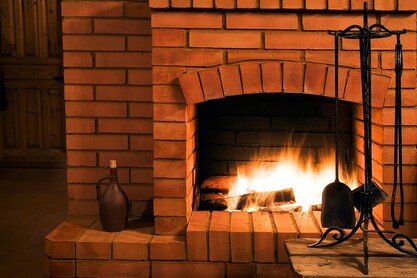|
It's a fair question, as the two are very similar, and in one case (the fireplace flue), they're the same. The two terms are often used interchangeably, even by industry insiders, as there is much overlap. But there are distinct differences between the two as well. Let's break it down What's the difference between a chimney and a flue?
A flue is the channel, pipe, or tube through which gases and smoke travel from a source of combustion (fireplace, furnace, boiler) to the outside environment. It is usually a vertical channel, but in some cases, as in fan-powered PVC power vents on newer, high-efficiency appliances, the flue can be horizontal. But here we are speaking of the traditional draft-style flue. That is, those that rely on natural draft—the upward movement of air as a result of differences in temperature and pressure—to safely vent the products of combustion from the home. A chimney is, on the other hand, in its simplest definition, the housing that encases the flue. It is usually made of masonry, brick, or stone. Its exterior, extending upward beyond the roof line, is generally what we think of when we consider chimneys. It's worth noting that a chimney that does not have a flue inside it or a liner is basically serving as the flue itself. How do chimney sweeping and flue cleaning differ? Bearing in mind that a flue is the path through which the byproducts of combustion vent to the outside, a "fireplace flue" is the same thing as what laypeople think of as a chimney—that structure which Santa will hopefully climb down later this month, if we're lucky. So, a fireplace flue cleaning and a chimney sweeping refer to the same process. During the service, the technician generally uses a stiff-bristled brush or other chimney cleaning system to brush the inside of the flue to remove creosote buildup from its walls. A utility flue cleaning—as opposed to a fireplace flue cleaning or chimney sweeping—would be focused on the vertical flue associated with the furnace, boiler, or water heater. Because these appliances do not generate creosote (which is a byproduct of burning wood), their flues typically do not get as dirty as fireplace flues, and the buildup they do accumulate is not as hard or caked-on, so to speak. For that reason, the tool of choice on a flue cleaning (though every technician is different) would be a tentacled air whip. Because these are powered pneumatically by air pressure rather than manually, they are highly efficient and are quite effective at removing the scale-and-sediment buildup prevalent within utility flues, as opposed to creosote, which requires more aggressive methods. How are they similar? The two processes are similar in that they are both designed to remove buildup and blockages from the inside of the flue to allow free and safe passage for the gases and smoke produced by combustion. In the case of blockage removal, the process is virtually identical, as the debris that blocks both fireplace flues and utility flues is almost always of the same origin: animal nesting. To remove it, the technician will break up the nest using whatever brush or whip will work most effectively, simultaneously sucking up the debris with a vacuum attached below. He'll then complete the job by thoroughly brushing (or whipping) the sides of the flue to remove any remaining or stuck-on debris. Finally, no body of information remotely associated with flue or chimney health would be complete without reference to the importance of chimney caps. They're vital, and without them, your roof has a gaping hole, inviting all kinds of weather damage and critter entry. It's the single easiest and most cost-effective way to maintain your chimney—or flue! Wanna dig deeper? Our flue cleaning service page has a detailed description of the process involved and tools used, as well as links for further reading. Learn More
0 Comments
Your comment will be posted after it is approved.
Leave a Reply. |
SearchArchives
April 2022
|
Twin Cities Furnace Cleaning - Open 7 Days a Week 8AM to 8PM

